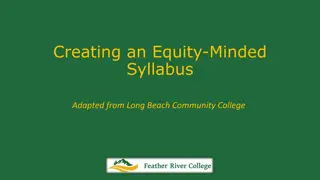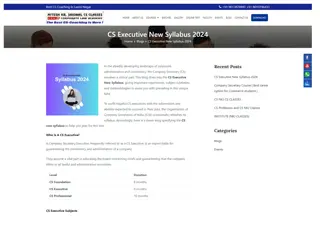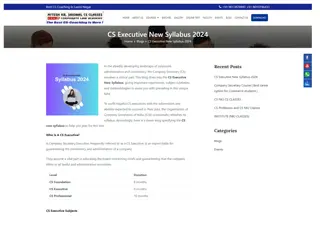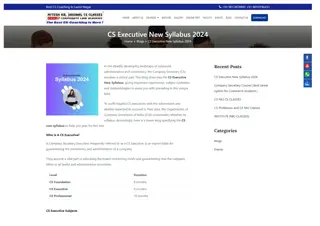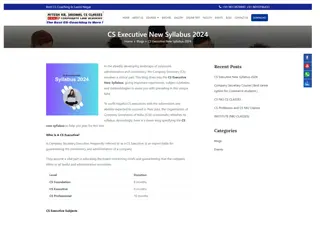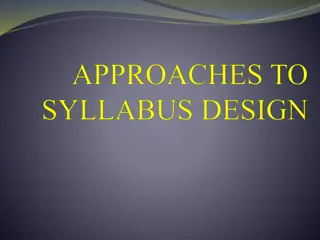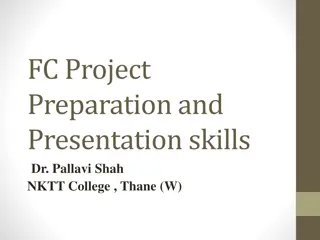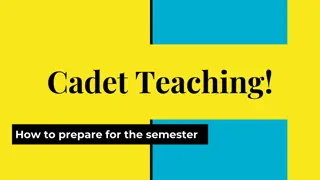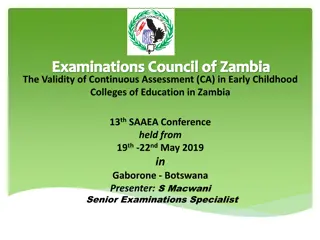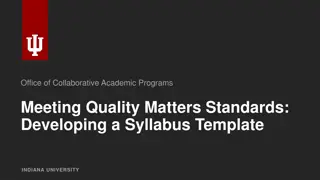Understanding the Importance of Creating an Effective Syllabus
Explore the multifaceted roles of a syllabus in higher education, from inviting students into a course to serving as a contractual agreement between instructors and learners. Learn about the key components of a syllabus, its functions, and innovative approaches to syllabus design. Discover why traditional syllabi are being reimagined and how digital and graphic syllabi can enhance student engagement and understanding.
Download Presentation

Please find below an Image/Link to download the presentation.
The content on the website is provided AS IS for your information and personal use only. It may not be sold, licensed, or shared on other websites without obtaining consent from the author. Download presentation by click this link. If you encounter any issues during the download, it is possible that the publisher has removed the file from their server.
E N D
Presentation Transcript
The Syllabus Kate Browne & Carmela Ferrad ns nonorg presentation 1.11.2016
todays nonorg The Syllabus: Part I The purposes of the syllabus Sample syllabi Information you should include in your syllabus A syllabus template for IWU The syllabus as a reading & writing assignment The Syllabus: Part II info, graphics and info-graphics
The Syllabus: Part One purposes, uses and samples
syllabus (n) 1650s, "table of contents of a series of lectures, etc.," from Late Latin syllabus "list," ultimately a misreading of Greek sittybos "parchment label, table of contents," of unknown origin. The misprint appeared in a 15c. edition of Cicero's "Ad Atticum" (see OED). Had it been a real word, the proper plural would be syllabi. http://www.etymonline.com/index.php?term=syllabus
The purposes of the syllabus A syllabus has several functions. The first function is to invite students to your course--to inform them of the objectives of the course and to provide a sense of what the course will be like. The second function is to provide a kind of contract between instructors and students to document expectations for assignments and grade allocations. The third function is to provide a guiding reference a resource to which students and instructional staff can refer for logistical information such as the schedule for the course and office hours, as well as rationale for the pedagogy and course content. http://bokcenter.harvard.edu/syllabus-design 1. to invite students to your course (course description, learning objectives, description of assignments) 2. to provide a contract between students and instructor (expectations for assignments and grading) 3. to provide a guiding reference (schedule, office hours, due dates, and teaching philosophy) Other resources Teaching at its Best by Linda B. Nilson, 2010. Chapter 3: The Complete Syllabus (33-41) Engaging Ideas by John C. Bean, 2011 Death to the Syllabus by Mano Singhan, 2007 https://www.aacu.org/publications-research/periodicals/death-syllabus It is time to declare war on the traditional course syllabus. If there is one single artifact that pinpoints the degradation of liberal education, it is the rule-infested, punitive, controlling syllabus that is handed out to students on the first day of class.
Sample Syllabi The Traditional Print-oriented Syllabus https://www.iwu.edu/melloncenter/rubrics-and-syllabi.html The Digital Syllabus Prof. Erin McLaughlin Multimedia and Rhetoric https://magic.piktochart.com/output/2570368-syllabus-wr- 13300#.VdZYZXQw6FR.gmail The Graphic Syllabus The Graphic Syllabus and the Outcomes Map: Communicating your Course by Linda Nilson 2007. Nilson s argument: when key information about a course, such as its structure, content, and assignments, is presented through graphics, it will be more easily understood and retained by students. http://azargrammar.com/teacherTalk/blog/2010/01/using-graphic-syllabi-in-your-classroom/
sample graphic syllabus 1 http://azargrammar.com/teacherTalk/blog/2010/01/us ing-graphic-syllabi-in-your-classroom/
sample graphic syllabus 2 http://chronicle.com/blogs/profhacker/graphic-display-of-student- learning-objectives/27863
sample graphic syllabus 3 http://blogs.agu.org/geoedtrek/2014/08/06/graphic-syllabus/
sample graphic syllabus 4 Prof. Lynda Barry
What to include in your syllabus http://bokcenter.harvard.edu/syllabus-design Learning Objectives: What students will gain or take away from your course. Why these objectives are the most important skills/knowledge for the course (helpful if objectives are included for each topic/session). 1. Goal/Rationale: How the course relates to primary concepts and principles of the discipline (where it fits into the overall intellectual area). Type of knowledge and abilities that will be emphasized. How and why the course is organized in a particular sequence. 2. Basic Information: Course name and number, meeting time and place, instructor name, contact information, office hours, instructional support staff information. 3. Course Content: Schedule, outline, meeting dates and holidays, major topics and sub-topics preferably with rationale for inclusion. 4. Student Responsibilities: Particulars and rationale for homework, projects, quizzes, exams, reading requirements, participation, due dates, etc. Policies on lateness, missed work, extra credit, etc. 5. Grading Method: Clear, explicit statement of assessment process and measurements. 6. Materials and Access: Required texts and readings, course packs. How to get materials including relevant instructional technologies. Additional resources such as study groups, etc. 7. Teaching Philosophy: Pedagogical approach including rationale for why students will benefit from it. 8.
Information you should include in your syllabus IWU Faculty Responsibilities, Resources and Related Policies (Faculty Handbook, Chapter V) "Each faculty member is required to produce and distribute, preferably at the first class meeting, but in any event within the first week of classes, a written syllabus explaining the aims, scope and format of the course, readings and other class experiences, such as class discussions, panels, quizzes, papers, and examinations. The syllabus must also include class attendance policy, grading policy, and office hours. Written course outlines, where appropriate, are strongly encouraged." (Faculty Handbook, Chapter V-9, 3.Course Syllabi) aims scope and format readings class experiences attendance policy grading policy office hours
2015-16 Course Catalog The Academic Program (64-67) Class attendance Attendance policies are established by individual faculty members for each class and therefore may vary from course to course. Students may expect the course attendance policy to be stated in the syllabus for that course. However, in general, students are expected to attend classes regularly. 64-65 Final examinations Comprehensive final examinations are not a mandatory part of every course, but a final exam or other activity must be administered during the scheduled final examination period. 65 Grade designations and quality points Credit at Illinois Wesleyan University is awarded on the basis of criteria of subject mastery or competence. The University does not use a uniform range of percentage scores in determining letter grades, nor does it award a predetermined percentage of letter grades in the various grade categories. Student academic performance is evaluated according to the following system of grade and quality point designations: Only letter grades count toward the GPA, A, A- Credit for work of superior quality. B+, B, B- Credit for work of good to very good quality. C+, C Credit for work of acceptable but not distinguished quality. C- Credit for work of marginal quality. D Credit for work of poor quality. F Failure (65-66)
a syllabus template for IWU courses Basic Information: Course name and number, meeting time and place, instructor name, contact information, office hours. 1. 2. Course Description. 3. Course Learning Goals. Materials and Access. 4. 5. Grading Method and Grading Scale. 6. Class Attendance Policy. 7. Course Policy. A tentative daily/weekly schedule with dates for major projects, exams and quizzes. 8. For IWU syllabi templates, please see the Mellon Center Web page https://www.iwu.edu/melloncenter/rubrics-and- syllabi.html
reading & writing assignments based on your syllabi 1.-In-class activities for the first day of class. Go over the syllabus yourself, then allow some time for the students to read it. Break the class into small groups to do one of the following activities: (Nilson, 40) a. discuss the document and answer each-other s questions about it; b. make a list of questions they should never ask you because the answer is on the syllabus; c. send the students on a scavenger hunt for critical information. 2.-Assign it as homework, answer questions about it the second day of class and have the students sign a contract with statements like this I have read the course syllabus and understand its contents. (Nilson, 40) 3.-Assign it as homework and give a graded test on it on the second day of class (Nilson, 40)
SPAN 307 Reading & Writing Culture (W,G) spring 206 Prof. Carmela Ferrad ns cferrada@iwu.edu 556-3155 Office: BUCK 206 & CLA 328, cferrada@iwu.edu Office Hours: M 11-noon, M&W 3:15-4:00PM in Buck 206; TTH 2:30-4:00 in CLA 328 "Culture" is one of the most searched words in the web, and has different meanings depending on context. What do we mean when we say "latin@, Caribbean, Spanish or Latin American cultures"? What are the social and political nuances of the word "culture" in these contexts? assignment-based course, we will explore a variety of research strategies pertaining to the study of these cultures, and analyze, compare and contrast different cultural practices and discourses in Spanish, Latin American, and US Latin@ & Caribbean societies. Busca SPA 307 en Moodle http://courses.iwu.edu In this Span 307 first paragraphs of the analog syllabus Span 307: An attempt for a digital syllabus
The Syllabus: Part Two Info, graphics, and infographics
Case Study: Gateway Fall 2015 Link to sample syllabus Benefits of using a digital, cloud-based syllabus Always available for students Saves paper (cliche, but true!) Students can modify according to their needs download or print font size/style, font color, highlight personal annotations
Case Study: Gateway Fall 2015 If I had to do it all again add more graphics or interactivity! A boring syllabus in the cloud is a boring syllabus on paper teach first-year students what a syllabus is and how to use it develop an activity that asks students to engage with content and form as a skill-based exercise
Technologies to Create Syllabi Analog Pen(cil) and paper Typewriter Art tools (paint, crayons, markers, chalk, etc.) Or experiment with mixed media! Digital word processing software (Word, Notepad, Google Docs) mapping/presentation software (MindMeister, PowerPoint, Prezi) drawing software (Photoshop, MS Paint, Piktochart, tablet & pen) Link to Piktochart experiment
Things to Consider Do you want to learn a new technology? If so, how much time do you want to spend learning? How do your biases influence appropriate use of technology? How will different media integrate with other elements for your course? Example: how well does a Piktochart integrate into Moodle? (spoiler alert: not well) Can students access your syllabus in multiple ways? How accessible is your syllabus? How do you want students to interact and engage with your syllabus?




